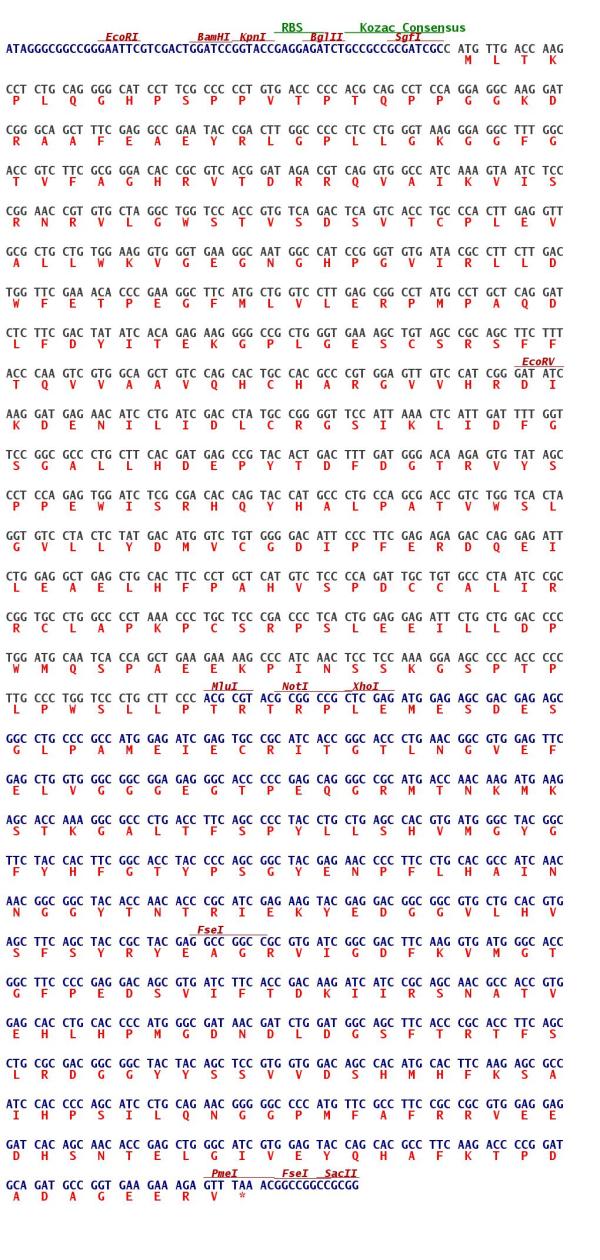Pim2 (BC027376) Mouse Tagged ORF Clone
SKU
MG204426
Pim2 (tGFP-tagged) - Mouse proviral integration site 2 (cDNA clone MGC:37188 IMAGE:4954711)
-
TrueORF®
TrueORF®
Expression-ready ORF plasmid with C-terminal tag(s)
Click here to learn more.
| Product Data | |
| Type | Mouse Tagged ORF Clone |
|---|---|
| Target Symbol | Pim2 |
| Synonyms | DXCch3; Pim-2 |
| Vector | pCMV6-AC-GFP |
| E. coli Selection | Ampicillin (100 ug/mL) |
| Mammalian Cell Selection | Neomycin |
| Sequence Data |
ORF Nucleotide Sequence
>MG204426 representing BC027376
Red=Cloning site Blue=ORF Green=Tags(s) TTTTGTAATACGACTCACTATAGGGCGGCCGGGAATTCGTCGACTGGATCCGGTACCGAGGAGATCTGCC GCCGCGATCGCC ATGTTGACCAAGCCTCTGCAGGGGCATCCTTCGCCCCCTGTGACCCCCACGCAGCCTCCAGGAGGCAAGG ATCGGGCAGCTTTCGAGGCCGAATACCGACTTGGCCCCCTCCTGGGTAAGGGAGGCTTTGGCACCGTCTT CGCGGGACACCGCGTCACGGATAGACGTCAGGTGGCCATCAAAGTAATCTCCCGGAACCGTGTGCTAGGC TGGTCCACCGTGTCAGACTCAGTCACCTGCCCACTTGAGGTTGCGCTGCTGTGGAAGGTGGGTGAAGGCA ATGGCCATCCGGGTGTGATACGCCTTCTTGACTGGTTCGAAACACCCGAAGGCTTCATGCTGGTCCTTGA GCGGCCTATGCCTGCTCAGGATCTCTTCGACTATATCACAGAGAAGGGGCCGCTGGGTGAAAGCTGTAGC CGCAGCTTCTTTACCCAAGTCGTGGCAGCTGTCCAGCACTGCCACGCCCGTGGAGTTGTCCATCGGGATA TCAAGGATGAGAACATCCTGATCGACCTATGCCGGGGTTCCATTAAACTCATTGATTTTGGTTCCGGCGC CCTGCTTCACGATGAGCCGTACACTGACTTTGATGGGACAAGAGTGTATAGCCCTCCAGAGTGGATCTCG CGACACCAGTACCATGCCCTGCCAGCGACCGTCTGGTCACTAGGTGTCCTACTCTATGACATGGTCTGTG GGGACATTCCCTTCGAGAGAGACCAGGAGATTCTGGAGGCTGAGCTGCACTTCCCTGCTCATGTCTCCCC AGATTGCTGTGCCCTAATCCGCCGGTGCCTGGCCCCTAAACCCTGCTCCCGACCCTCACTGGAGGAGATT CTGCTGGACCCCTGGATGCAATCACCAGCTGAAGAAAAGCCCATCAACTCCTCCAAAGGAAGCCCCACCC CCTTGCCCTGGTCCCTGCTTCCC ACGCGTACGCGGCCGCTCGAG - GFP Tag - GTTTAA
Protein Sequence
>MG204426 representing BC027376
Red=Cloning site Green=Tags(s) MLTKPLQGHPSPPVTPTQPPGGKDRAAFEAEYRLGPLLGKGGFGTVFAGHRVTDRRQVAIKVISRNRVLG WSTVSDSVTCPLEVALLWKVGEGNGHPGVIRLLDWFETPEGFMLVLERPMPAQDLFDYITEKGPLGESCS RSFFTQVVAAVQHCHARGVVHRDIKDENILIDLCRGSIKLIDFGSGALLHDEPYTDFDGTRVYSPPEWIS RHQYHALPATVWSLGVLLYDMVCGDIPFERDQEILEAELHFPAHVSPDCCALIRRCLAPKPCSRPSLEEI LLDPWMQSPAEEKPINSSKGSPTPLPWSLLP TRTRPLE - GFP Tag - V |
| Restriction Sites |
SgfI-MluI Cloning Scheme for this gene
Plasmid Map

|
| ACCN | BC027376 |
| ORF Size | 933 bp |
| OTI Disclaimer | The molecular sequence of this clone aligns with the gene accession number as a point of reference only. However, individual transcript sequences of the same gene can differ through naturally occurring variations (e.g. polymorphisms), each with its own valid existence. This clone is substantially in agreement with the reference, but a complete review of all prevailing variants is recommended prior to use. More info |
| OTI Annotation | This clone was engineered to express the complete ORF with an expression tag. Expression varies depending on the nature of the gene. |
| Components | The ORF clone is ion-exchange column purified and shipped in a 2D barcoded Matrix tube containing 10ug of transfection-ready, dried plasmid DNA (reconstitute with 100 ul of water). |
| Reconstitution Method | 1. Centrifuge at 5,000xg for 5min. 2. Carefully open the tube and add 100ul of sterile water to dissolve the DNA. 3. Close the tube and incubate for 10 minutes at room temperature. 4. Briefly vortex the tube and then do a quick spin (less than 5000xg) to concentrate the liquid at the bottom. 5. Store the suspended plasmid at -20°C. The DNA is stable for at least one year from date of shipping when stored at -20°C. |
| Note | Plasmids are not sterile. For experiments where strict sterility is required, filtration with 0.22um filter is required. |
| Shipping | Ambient |
| Reference Data | |
| RefSeq | BC027376, AAH27376 |
| RefSeq Size | 1974 bp |
| RefSeq ORF | 935 bp |
| Locus ID | 18715 |
| Cytogenetics | X 3.55 cM |
| Summary | Proto-oncogene with serine/threonine kinase activity involved in cell survival and cell proliferation. Exerts its oncogenic activity through: the regulation of MYC transcriptional activity, the regulation of cell cycle progression, the regulation of cap-dependent protein translation and through survival signaling by phosphorylation of a pro-apoptotic protein, BAD. Phosphorylation of MYC leads to an increase of MYC protein stability and thereby an increase of transcriptional activity. The stabilization of MYC exerted by PIM2 might explain partly the strong synergism between these 2 oncogenes in tumorigenesis. Regulates cap-dependent protein translation in a mammalian target of rapamycin complex 1 (mTORC1)-independent manner and in parallel to the PI3K-Akt pathway. Mediates survival signaling through phosphorylation of BAD, which induces release of the anti-apoptotic protein Bcl-X(L)/BCL2L1. Promotes cell survival in response to a variety of proliferative signals via positive regulation of the I-kappa-B kinase/NF-kappa-B cascade; this process requires phosphorylation of MAP3K8/COT. Promotes growth factor-independent proliferation by phosphorylation of cell cycle factors such as CDKN1A and CDKN1B. Involved in the positive regulation of chondrocyte survival and autophagy in the epiphyseal growth plate.[UniProtKB/Swiss-Prot Function] |
Write Your Own Review
| Product Manuals |
| FAQs |
| SDS |
| SKU | Description | Size | Price | |
|---|---|---|---|---|
| MC217731 | Pim2 (untagged) - Mouse proviral integration site 2 (cDNA clone MGC:37188 IMAGE:4954711), (10ug) | 10 ug |
$330.00
|
|
| MR204426 | Pim2 (Myc-DDK-tagged) - Mouse proviral integration site 2 (cDNA clone MGC:37188 IMAGE:4954711) | 10 ug |
$289.00
MSRP
$300.00
MSRP
$300.00
|
|
| MR204426L3 | Lenti ORF clone of Pim2 (Myc-DDK-tagged) - Mouse proviral integration site 2 (cDNA clone MGC:37188 IMAGE:4954711) | 10 ug |
$600.00
|
|
| MR204426L4 | Lenti ORF clone of Pim2 (mGFP-tagged) - Mouse proviral integration site 2 (cDNA clone MGC:37188 IMAGE:4954711) | 10 ug |
$600.00
|
|
Citations
*Delivery time may vary from web posted schedule. Occasional delays may occur due to unforeseen
complexities in the preparation of your product. International customers may expect an additional 1-2 weeks
in shipping.






